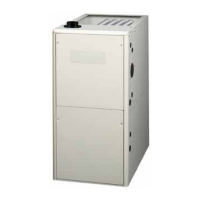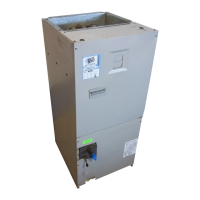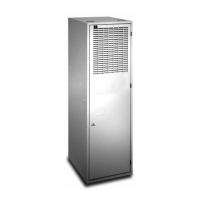4
REQUIREMENTS & CODES
WARNING:
The safety informationlisted below mustbe
followedduring theinstallation, service,and
operationofthisfurnace.Failuretofollowsafety
recommendations could result in possible
damage to the equipment, serious per
sonal
injuryordeath
.
• This furnace must be installed in accordance with
these instructions, all applicable local building codes
and the current revision of the National Fuel Gas Code
(NFPA54/ANSI Z223.1) or the Natural Gas and Propane
Installation Code, CAN/CGA B149.1.
• Use onlywithtypeofgasapprovedforthisfurnace.
Refer to the furnace rating plate.
• Install this furnaceonlyinalocationand position as
specified on page 6.
• Provideadequatecombustionandventilationairtothe
furnace space as specified on pages 7 - 14.
• Provideadequateclearancesaroundtheventairintake
terminal as specified in Figure 7 (page 12), Figure 8
(page 12), Figure 9 (page 13), & Figure 10 (page
13).
• Combustion products must be discharged outdoors.
Connect this furnace to an approved vent system only,
as specified on pages 10 - 14.
• Never test for gas leaks with an open ame. Use
a commercially available soap solution to check all
connections. See page 21.
• Thisfurnaceisdesignedtooperatewithamaximum
external pressure rise of 0.5 inches of water column.
Consult Table 6 (page 33), Table 7 (page 34), &
Table 8 (page 35), and the rating plate for the proper
circulating air flow and temperature rise. It is important
that the duct system be designed to provide the correct
flow rates and external pressure rise. An improperly
designed duct system can result in nuisance shutdowns,
and comfort or noise issues.
• Whensupplyductscarryaircirculatedbythefurnace
to areas outside the space containing the furnace, the
return air shall also be handled by duct(s) sealed to
the furnace casing and terminating in the conditioned
space. See pages 14 - 15.
• Agas-redfurnaceforinstallationinaresidentialgarage
must be installed as specified on page 6.
• This furnace may be used for temporary heating of
buildings or structures under construction. See the
guidelines listed on page 6.
• Thisfurnaceisnotapprovedforinstallationinmobile
homes. Installing this furnace in a mobile home could
cause fire, property damage, and/or personal injury.
• The Commonwealth of Massachusetts requires
compliance with regulation 248 CMR 4.00 and 5.00 for
installation of through – the – wall vented gas appliances
as follows:
1. For direct-vent appliances, mechanical-vent heating
appliances or domestic hot water equipment, where the
bottom of the vent terminal and the air intake is installed
below four feet above grade the following requirements
must be satisfied:
a.) A carbon monoxide (CO) detector and alarm shall
be placed on each floor level where there are
bedrooms. The detector shall comply with NFPA
720 (2005 Edition) and be mounted in the living
area outside the bedroom(s).
b.) A (CO) detector shall be located in the room that
houses the appliance or equipment and shall:
•Bepoweredbythesameelectricalcircuitasthe
appliance or equipment. Only one service switch
shall power the appliance and the (CO) detector;
•Havebatteryback-uppower;
•MeetANSI/UL2034Standardsandcomplywith
NFPA 720 (2005 Edition); and Approved and listed
by a Nationally Recognized Testing Laboratory
as recognized under 527 CMR.
c.) A Product-approved vent terminal must be
used, and if applicable, a product-approved air
intake must be used. Installation shall be in strict
compliance with the manufacturer’s instructions.
A copy of the installation instructions shall remain
with the appliance or equipment at the completion
of the installation.
d.) A metal or plastic identification plate shall be
mounted at the exterior of the building, four feet
directly above the location of vent terminal. The
plate shall be of sufficient size, easily read from
a distance of eight feet away, and read “Gas Vent
Directly Below”.
2. For direct-vent appliances, mechanical-vent heating
appliances or domestic hot water equipment where the
bottom of the vent terminal and the air intake is installed
above four feet above grade the following requirements
must be satisfied:
a.) A (CO) detector and alarm shall be placed on each
floor level where there are bedrooms. The detector
shall comply with NFPA 720 (2005 Edition) and be
mounted in the living area outside the bedroom(s).
b.) The (CO) detector shall:
•Belocatedintheroomthathousestheappliance
or equipment;
•Behard-wiredorbatterypoweredorboth.
•ShallcomplywithNFPA720(2005Edition).
c.) A product-approved vent terminal must be
used, and if applicable, a product-approved air
intake must be used. Installation shall be in strict
compliance with the manufacturer’s instructions.
A copy of the installation instructions shall remain
with the appliance or equipment at the completion
of the installation.

